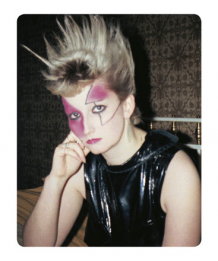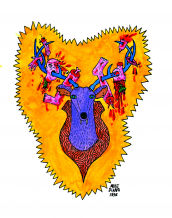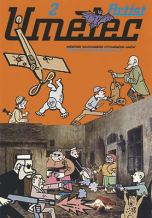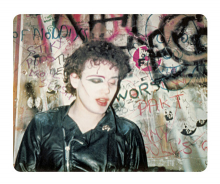| Zeitschrift Umělec 2004/1 >> Virtual Art — the Aura of the Digital "Fortunately it is unknown where the journey will end." - An interview with Dr. Oliver Grau,Berlin, Germany | Übersicht aller Ausgaben | ||||||||||||
|
|||||||||||||
Virtual Art — the Aura of the Digital "Fortunately it is unknown where the journey will end." - An interview with Dr. Oliver Grau,Berlin, GermanyZeitschrift Umělec 2004/101.01.2004 Susanne Schuricht | interview | en cs |
|||||||||||||
|
Dr. Oliver Grau is a media art historian, researching and lecturing at the Department of Art History at Humboldt University, Berlin. He studied art history, economics, archaeology and Italian literature in Hamburg, London and Siena. He also did field research in the USA and Japan. Since 1988 he has been head of the German Science Foundation project on art history and media theory of virtual reality. He and his team are developing a database for virtual art, which will give an overview of interactive installations from past decades. He has published widely in Europe, the USA and Japan. His research focuses on the history of illusion and immersion in media and art, the history of the idea and the culture of telepresence and telecommunication, genetic art and artificial intelligence. Dr. Oliver Grau is author of the book Virtual Art: From Illusion to Immersion published in 2003 by MIT Press.
When did you first come into contact with computers? In the 70s, 1973 or 1974, when my father brought home the then brand new computer game Pong. He was teaching “digital technology” then at the University of Hamburg and had covered it himself with his students at the lab. I could always play their results at home with my friends. So long before the arrival of computer games on the market we were sticking colored plastic foil to the screen of our black and white TV, thus greatly extending the variety of Pong. How would you describe your research in a single sentence? How do people live with images? What are the sorts of powers, suggestions images have over their viewers — historically as well as now; how are we able to renew our media literacy? Where do your interests in virtual reality and virtual arts come from? After my civil service and studies I traveled extensively through Polynesia, Central Asia and the Americas. At the beginning of the 90s, virtual reality, or the idea of placing a person into an illusionary location by immersing him in images, was associated with a hype that is hardly comprehensible nowadays: There where the supporters and utopians on one side and those heralding the apocalypse on the other, like Virilio and Kamper. They assumed that we were about to get rid of the physical body and become lost in computer-generated worlds. For me, as someone who liked to travel extensively and who had explored the limits of his body, virtual reality was an intriguing phenomenon; Explosive, perhaps even threatening from a politics of the body point of view — yet full of fascinating possibilities. Insofar as my desire for faraway places merged with my scientific curiosity for virtual computer-generated worlds. I wanted to explore what was happening to the Other in the momentarily interconnectedness of matrix and cyberspace. How does the concept of a work of art change under the conditions of computer generated, virtual quality? In a nutshell one might say that the work of art loses its local reference. It is open, process oriented, increasingly interactive, three- sometimes even poly-dimensional and temporally variable. Before us lies the question of what a work of art is — as it cannot exist without a spectator, a user. If we were to attempt to assign Benjamin’s classic term “the Aura” to the digital work of art, in one sense the Aura is lost, because there is no original, as there may be an infinite number of identical copies. … We have to keep in mind that digital works of art stand before the massive problem of preservation, something thus far unheard of.. Works created as recently as ten years ago are almost impossible to exhibit, as operating systems and storage media have developed since then. Additionally there are no elaborate strategies for the conservation of digital art! How should media art by exhibited, collected? Does it make sense for museums to continue to exist? Artists who have enriched us with intriguing works of art may be unable to show us the circumstances of the most recent history. This is something that not only the artist but also a culturally interested society is seriously worried about. A society that relies on archives and preserves the past as cultural memory cannot afford to let works of art which aesthetically comprise our times fade away. This would be inexcusable. We need strategies to preserve these works of art. Primarily this means documentation. This is the foundation to confirm that these art works have been created during the past years, and reasonable politics of collection should be considered. I expect a joint initiative between artists, computing centers, technology museums, manufacturers and traditional museums to save at least the most important works of our times. We must not surrender to prevalent technical or art-political obstacles. Had courageous museum people not defied the Zeitgeist at the turn of the last century there would be no Impressionists or Expressionists in any of our museums. So let’s spare ourselves from having to answer to future generations on why we did nothing to stop the loss of media art. The database that is being developed at Humboldt University under your supervision in the research project on virtual art is already a substantial contribution. This database can only be a first initiative to get an overview and to trigger discussions about which works to save and in which way. … The kind of problem solving available in ten to twenty years is not yet foreseeable. Yet it is necessary to begin now to do what we can. How was space suggested in the arts in the past — how is space experienced today? The revolution in the visualization of space was of course “perspective,” developed during the Renaissance and Baroque; although there were also attempts in the ancient world. In antiquity they achieved stupefying results not with mathematical methods, but through a series of tricks: as a result the Villa dei Misteri in Pompei or the Villa Livia near Rome still intrigue us. Later panoramas industrialized the procedures of representation of space. Large immersive spaces brought remote places right into the metropolises of the 19th century. Sometimes their effects where so suggestive that the observer truly went into a state of delirium from the perception… These panoramas were not a durable medium for storage — they were too big, and they became damaged during transport. Finally they were stored in the attics of museums. The famous Sedan panorama, for example, was burned during a bombing raid in the attic of the National Gallery [in Berlin]. The panoramas experienced a similar problem with storage. Towards the end of the 19th century it was the pictures of the cinema, which, though silent and black and white, where so impressive that viewers panicked when they saw them. A century later the cultural technique of interaction, though shaky spaces of low resolution, created a new impression of artificial imaginary spaces. At the beginning of the 1990s the hype surrounding these imaginary spaces was of such a magnitude in the worlds of entertainment, science and art that the ripples are still felt today. Many panoramas, like panoramas with battle scenes, have been used for propaganda purposes… Right, surprisingly the panorama underwent a remake as a propaganda format during the 1960s and 80s. For example in the former Soviet Union, Egypt, North Korea, China, Bulgaria and the Iraq. Most common were battle scenes that depicted the myth of the creation of the nation and which legitimized and founded a regime. On the other hand, the history of the panorama began rather peacefully. At the beginning they only demonstrated artistic skill and deftness of technique. Depictions of Paris were shown in Paris and people were astonished. …. Increasingly propagandistic tendencies emerged: battle scenes of the major wars… The panorama was the most advanced technique of illusionism at that time — before film, cinema and computer imagery. It was the most powerful medium, as we know from many statements from the time. Many sources testify that people began to feel nauseous simply by viewing depictions of scenes at sea, or battle scenes that appeared so suggestive that people expected to be trampled by horses that were merely painted well. Today we have become an extremely visual society. It requires a great deal to evoke a shocking experience. The threshold for immersion is rising higher and higher. Right, it’s incomparable to what our ancestors were exposed to. Generally one might say: while establishing a new medium of illusion a discrepancy between imaginative power and conscious, a reflective distance occurs. These differences come together again after continuous and conscious use. Adaptation wears down the illusionistic powers, and very soon it loses its capability to captivate our consciousness. It finally becomes stale, as the audience becomes dulled to the function of deception. Until finally a new medium with a higher sensory stimulus and more powerful potential of suggestion draws the spectator back under its spell. It is this mechanism — the competition between the media of illusion and the powers of rational distance — which has manifested in the European history of visual art over and over again since mediaeval times. At this point it would be worthwhile to commemorate the idea of Mimesis. Mimesis is a very old concept of the image, reaching far back into pre-civilization history. The German term “Bild” (“picture”) originates from the old Germanic root “bil,” and it still holds some of its etymological descent: it incorporated less a consciousness of the picture as such than an indication that something was, intrinsically, animate. It was an item that contained the power of the irrational, of a magical and ghostly enchantment that could not be captured or controlled by the spectator. If one understands the virtual not as a space of possibility, but as a characteristic sphere of the imaginary, it becomes clear that it is not about an aesthetic and conscious illusion — like the pleasure of mimetic reproduction — but rather about the temporary yet complete captivation of the consciousness. The question remains whether creating increasingly realistic depictions and interactions is the ultimate goal? If the threshold is pushed further and further, where does it all go? That’s the question. Although the development of visual media — from the Lantera Magica show to the Panorama, Stereoscope, Diorama, silent film, color film and IMAX, television and the virtual pictorial space of the computer — appears to be a history of machines in perpetual evolution. A change of modes of organization and materials that are continuously developed by the fascination of increasing the illusion. Yet I’m skeptical that there will finally be a medium of illusion that will be so seductive in its totality that we cannot resist. The tendency is, and history has borne this out, to always go one-up on the past. At the same time adaptation and conscious contact with new media increases media competence. That is one of the reasons why we should be very aware of the history of visual media. The more distanced our perception is, the more we are able to evaluate and criticize the hype around new media. Does media art make scientific processes illustratively comprehensible? This becomes increasingly apparent in the Artificial Life movement (A-Life), for example in the world of images created by Christa Sommerer and Laurent Mignonneau, Karl Sims or by Tom Ray. They appear to be a visual soundtrack for the most recent scientific theories of the bio-sciences. Art visualizes the latest scientific theories, makes them negotiable and delivers them to public discourse. Bioart provides highly visible icons for public discussions which otherwise would be much more abstract and alienated. At the same time a scientific propaganda emerges that enables rather shallow concepts with a suggestive, manipulative mediation to appear as concrete and animate. Collaborations among scientists and artists can be very fruitful. Artists, Leonardo da Vinci is a well-known example, have often been scientists at the same time. Even nowadays there are more artists working at research laboratories than one might expect. Worldwide there are Artist in Residence programs, at MIT or IAMAS in Japan. Monika Fleischmann and Wolfgang Strauss are good examples; both of them have tenure positions at the Fraunhofer Institute (Germany’s most prominent research institute) and have established teams of up to twenty members. Of course there are predecessors in the history of arts if one thinks of the big studios and workshops of the past centuries. This staff allows some artists not to have to create the work of art all by themselves. They have a variety of specialists available that collaborate like an orchestra. ... Just like the director of a film has to guide a whole team of people to produce a final product, it is the same in interactive computer art where the increasing use of technology leads to more and more complex visual worlds that are not possible to achieve in any other way than through the communicative and organizational talent of the artist. Perhaps this is related to the fact that many great names in the computer arts today are women. Christa Sommerer, Monika Fleischmann, Charlotte Davies are examples. … A media artist is nowadays less a conceptionist, designer, programmer or manager all rolled in one. Instead the media artist could be compared to a conductor. Indeed, successful artists are generalists. They are able to produce their political, visual or esthetical message through a good deal of communication and management. They have to connect many different issues to receive the maximum. The concept of the artist as an individual seems to be outdated by the media arts. The Van Goghs or Gauguins of the computer age, working in complex worlds, would have difficulty creating large-scale interactive works. They might be able to exist and may visualize their ideas as long as they are not too complex — for complex concepts you need a whole team to develop all the integrated components. Would you agree that it is possible to evaluate interactive art by the way the user interface is designed and conceived? This is in fact a key question for how the interface is designed. For example, how Christa Sommerer and Laurent Mignonneau have developed it in a way that their imaginative worlds are made intuitively accessible, or if they appear to be rather hermetic so that they can hardly be grasped. At the same time interactive artworks carry the danger that natural interfaces let them appear to be even more suggestive and immersive. Artists like Knowbotic Research try to create distance with their interfaces. I believe this does justice to their artistic-political responsibility by creating distance from their illusionary imaginative worlds, limiting their suggestive effects, and thus leaving space for abstraction and critical distance… for thinking space. Therefore we could say that this process is two edged. On the one hand the interface deserves to be intuitive and usable — on the other hand this becomes problematic. What in your opinion is the aim of media art? The aim of media art is no different from what has always been the responsibility of art: to search for aesthetic, political and individual messages that touch people and help us to better understand the present. At the same time media art, through interaction, narrative processes or databases that support imaginative worlds can give more expression than traditional art when skillful hands create it. An important responsibility of media art nowadays is to create critical interfaces that allow the spectator to keep a certain distance from all the hype about virtual spaces and suggestive computer worlds. On the one hand, there is the duty to explore the full media potential for the aesthetics, which by the way are far more complex than those of traditional artistic media. On the other hand it’s important not to let this process, this revolution of media, to be unleashed upon the spectator, subjecting them to unmediated images and interactions. We have the responsibility to educate a critical, enlightened gaze to make this media revolution more comprehensible. What do you think about “generative art,” imaginative worlds created by source code, where the artist does not know what is coming out at the end? This is in fact one of the most fascinating phenomena in computer arts. On the one hand it is utilized for the visualization and propagation of scientific theories, for example in the debate about genetics — on the other hand it’s a fascinating instrument that allows animation and enlivening through random processes. Imaginative worlds grow to unexpected results that depend only on a rough frame of selection that may be defined by the artist. In the sense of illusionism this may also lead to an additional effect of suggestiveness sending the work of art in unforeseeable directions. Additionally they have an interesting effect on the concept of the artistic work, the Werkbegriff. Ironically suddenly the concept of the “original” comes back into digital art, as each step in this process is a unique evolutionary development. Are there local differences in media art despite globalization? This is indeed a very exciting process: to observe the development of intercultural processes in media arts. That doesn’t only mean East-West, but also for North-South. There are amazing artists in Africa, South America, Mexico, Southeast Asia and even the Arctic. They use media art to contribute their local traditions to the worldwide exchange of images. By doing this they create interesting hybrid forms and art discourses — so that we end up where our conversation began: traveling. Intercultural processes are happening increasingly throughout media. This has positive as well as negative effects: on the one hand, telematics open up access to worlds of images that again open up new perspectives and insights. On the other hand, powerful structures like multinational corporations operating image databases, image industries like the globalised cinema industries monopolize images worldwide. This may lead to a monoculture of images, comparable to fast food which results in less variety and in a general leveling and egalitarianism which thwarts creativity. This process follows economical interests and is unpredictable. When was the last time you consciously looked at the stars – when was the last time you dove into the starry sky? The last time was at a wonderful feast during one of the hottest days of last year. It was about 40 degrees and we were at a stately home outside of Berlin. We danced all night long; it was completely dark and there was a fantastic starry sky luminously bright… it was the night of my wedding. From German to English: Michael Hohl
01.01.2004
Empfohlene Artikel
|
|||||||||||||
|
04.02.2020 10:17
Letošní 50. ročník Art Basel přilákal celkem 93 000 návštěvníků a sběratelů z 80 zemí světa. 290 prémiových galerií představilo umělecká díla od počátku 20. století až po současnost. Hlavní sektor přehlídky, tradičně v prvním patře výstavního prostoru, představil 232 předních galerií z celého světa nabízející umění nejvyšší kvality. Veletrh ukázal vzestupný trend prodeje prostřednictvím galerií jak soukromým sbírkám, tak i institucím. Kromě hlavního veletrhu stály za návštěvu i ty přidružené: Volta, Liste a Photo Basel, k tomu doprovodné programy a výstavy v místních institucích, které kvalitou daleko přesahují hranice města tj. Kunsthalle Basel, Kunstmuseum, Tinguely muzeum nebo Fondation Beyeler.
|


































 We Are Rising National Gallery For You! Go to Kyjov by Krásná Lípa no.37.
We Are Rising National Gallery For You! Go to Kyjov by Krásná Lípa no.37.
Kommentar
Der Artikel ist bisher nicht kommentiert wordenNeuen Kommentar einfügen